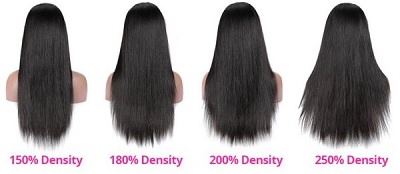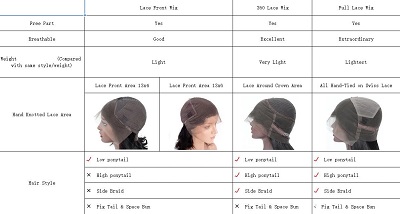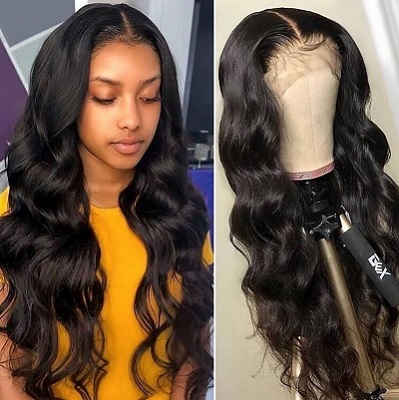Wigs have become a popular choice for those looking to enhance their style or deal with hair loss. With a wide range of options available, it can be overwhelming to choose the right wig that suits your needs. In this article, we will guide you through the process of selecting the perfect wig length, density, lace type, and cap size. Whether you are a wig enthusiast or a beginner, these tips will help you make an informed decision.

Wigs offer a versatile solution for individuals seeking to transform their appearance. However, to achieve the desired look, it is crucial to consider various factors such as wig length, density, lace type, and cap size. Each of these elements plays a significant role in determining how natural and comfortable the wig will feel when worn.
Choosing the Right Wig Length
The length of a wig is an important factor to consider as it greatly influences your overall look. When selecting the wig length, consider your facial features, personal style, and occasion. Here are a few popular wig lengths:
- Short-Length Wigs
Short length wigs are chic and easy to maintain. They are suitable for individuals who prefer a hassle-free hairstyle or those with a busy lifestyle. Short wigs can enhance facial features and provide a youthful appearance.
- Medium Length Wigs
Medium-length wigs offer versatility and a balanced look. They can be styled in various ways, allowing you to switch between casual and formal styles effortlessly. Medium-length wigs are a popular choice for everyday wear.
- Long Length Wigs
Long-length wigs are ideal for those who desire an elegant and glamorous look. These wigs offer ample styling options, allowing you to experiment with different hairstyles. However, it’s important to note that long wigs require more maintenance and care.
Understanding Wig Density
Wig density refers to the amount of hair on a wig cap. Choosing the right density is crucial for achieving a natural and realistic look. Here are some common wig density options:
- Light Density
Light-density wigs have fewer hair strands, resulting in a natural and lightweight appearance. They are suitable for individuals who prefer a more subtle and realistic look.
- Medium Density
Medium-density wigs strike a balance between naturalness and fullness. They offer a thicker appearance without appearing overly dense, making them a popular choice for everyday wear.
- High Density
High-density wigs are characterized by a fuller and more voluminous look. They are suitable for individuals who desire a dramatic and glamorous hairstyle. High-density wigs are often chosen for special occasions or performances.
Selecting the Appropriate Lace Type
The lace type of a wig determines its breathability and natural look. There are two common lace types used in wigs:

- Swiss Lace
Swiss lace is delicate and creates a seamless blend with the scalp when properly applied. It offers a natural hairline and allows for easy styling. However, Swiss lace wigs require careful handling to avoid damage.
- HD Lace
HD lace, also known as high-definition lace, is a thinner and more transparent lace material. It provides an undetectable hairline and blends effortlessly with various skin tones. HD lace wigs offer a realistic appearance, making them a popular choice among wig enthusiasts.
Determining the Ideal Cap Size
Selecting the appropriate cap size ensures a comfortable and secure fit. Ill-fitting wigs can be uncomfortable and may not provide the desired appearance. Here are a few tips to determine your ideal cap size:
- Measure Your Head Circumference
Use a flexible tape measure to measure the circumference of your head. Start at your hairline, go behind your ear, and back to the starting point. This measurement will help you determine the right cap size.
- Consider Your Hair Type
If you have thick or long hair, you may need a slightly larger cap size to accommodate your natural hair. On the other hand, individuals with shorter or thinner hair may opt for a smaller cap size.
- Consult a Wig Specialist
If you are unsure about your cap size or have specific requirements, it is advisable to consult a wig specialist. They can provide professional guidance and assist you in finding the perfect fit.

Conclusion
Selecting the right wig length, density, lace type, and cap size is essential for achieving a natural and comfortable look. By considering your personal preferences, facial features, and lifestyle, you can choose a wig that enhances your style and boosts your confidence. Remember to take proper care of your wig to ensure its longevity and maintain its appearance.
You can also get: 13 Best Beauty Supplements Of 2023 & How To Choose
FAQs
Q1: Can I style a wig with a different length than my natural hair?
Yes, wigs allow you to experiment with different lengths regardless of your natural hair. You can easily change your look by choosing a wig with a different length.
Q2: How do I clean and maintain my wig?
Proper maintenance is crucial to ensure the longevity of your wig. Follow the manufacturer’s guidelines for cleaning and use recommended products to keep your wig in optimal condition.
Q3: Can I wear a wig while exercising or swimming?
While it is possible to wear a wig during exercise or swimming, it is advisable to secure it properly and consider using a waterproof adhesive or wig cap to protect the wig from moisture and movement.
Q4: How often should I replace my wig?
The lifespan of a wig depends on various factors, including the quality of the wig, frequency of wear, and maintenance. On average, wigs can last for several months to a year with proper care.
Q5: Can I dye a synthetic wig?
It is generally not recommended to dye a synthetic wig as the synthetic fibers may not react well to hair dye. However, some specialty dyes designed specifically for synthetic wigs may be available.


